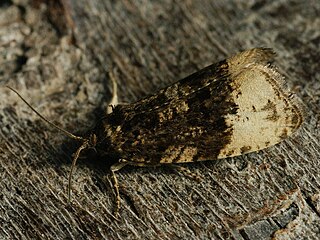
Euchaetis rhizobola is a moth of the family Oecophoridae. It is found in Australia, including New South Wales, Queensland, the Australian Capital Territory, Victoria, South Australia and Western Australia.

Apamea oblonga, the crescent striped, is a moth of the family Noctuidae. The species was first described by Adrian Hardy Haworth in 1809. It is found in northern and central Europe, east to southern Russia, Asia Minor, Armenia, Turkestan, Turkey, Iran, southern Siberia, northern Pakistan, Mongolia, China, Sakhalin and Japan

The double-spot brocade is a species of moth of the family Noctuidae. It is found in most of Europe, in Turkey and the west of Iran. In Anatolia it is represented by the subspecies Meganephria bimaculosa pontica.

Ypsolopha nemorella is a moth of the family Ypsolophidae. It is found in northern and central Europe, mid-eastern China and Russia.

Hedya ochroleucana, the buff-tipped marble or long-cloaked marble, is a moth of the family Tortricidae. It is found in most of Europe, except part of the Balkan Peninsula and Ukraine and east across the Palearctic. It is also present in most of North America.
Holocola obeliscana is a species of moth of the family Tortricidae. It is found in Australia, where it has been recorded from Queensland and New South Wales.
Prodelaca myodes is a moth in the family Oecophoridae. It was described by Edward Meyrick in 1883. It is found in Australia, where it has been recorded from Queensland and New South Wales.
Ironopolia neochlora is a moth in the family Oecophoridae. It was described by Edward Meyrick in 1883. It is found in Australia, where it has been recorded from Queensland.
Garrha sericata is a moth in the family Oecophoridae. It was described by Edward Meyrick in 1883. It is found in Australia, where it has been recorded from Queensland and New South Wales.
Dichomeris thanatopsis is a moth in the family Gelechiidae. It was described by Oswald Bertram Lower in 1901. It is found in Australia, where it has been recorded from Queensland.
Recurvaria saxea is a moth of the family Gelechiidae. It is found in Brazil (Para).

Aproaerema simplexella, the soybean moth, is a moth in the family Gelechiidae. It was described by Francis Walker in 1864. It is found in India, China, Australia, Norfolk Island and New Zealand. It is an invasive species in Africa, where it has since been recorded from the Democratic Republic of the Congo, Malawi, South Africa and Uganda.
Thiotricha atractodes is a moth of the family Gelechiidae. It was described by Edward Meyrick in 1922. It is found in Australia, where it has been recorded from Queensland.
Gomphoscopa is a monotypic moth genus in the family Xyloryctidae. Its only species, Gomphoscopa catoryctopsis, is found in the Australian state of South Australia. Both the genus and species were first described by Oswald Bertram Lower in 1893.
Zaphanaula hemileuca is a moth in the family Xyloryctidae, and the only species in the genus Zaphanaula. It was described by Turner in 1896. It is found in Australia, where it has been recorded from Queensland.
Boydia stenadelpha is a moth in the family Xyloryctidae. It was described by Oswald Bertram Lower in 1905. It is found in Australia, where it has been recorded from New South Wales.
Cryptophasa themerodes is a moth in the family Xyloryctidae. It was described by Turner in 1904. It is found in Australia, where it has been recorded from Queensland.
Xylorycta melanula is a moth in the family Xyloryctidae. It was described by Edward Meyrick in 1890. It is found in Australia, where it has been recorded from New South Wales.
Agriophara poliopepla is a moth in the family Depressariidae. It was described by Alfred Jefferis Turner in 1898. It is found in Australia, where it has been recorded from Queensland.
Chlamydastis leucoptila is a moth in the family Depressariidae. It was described by Edward Meyrick in 1918. It is found in French Guiana and Guatemala.





